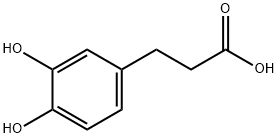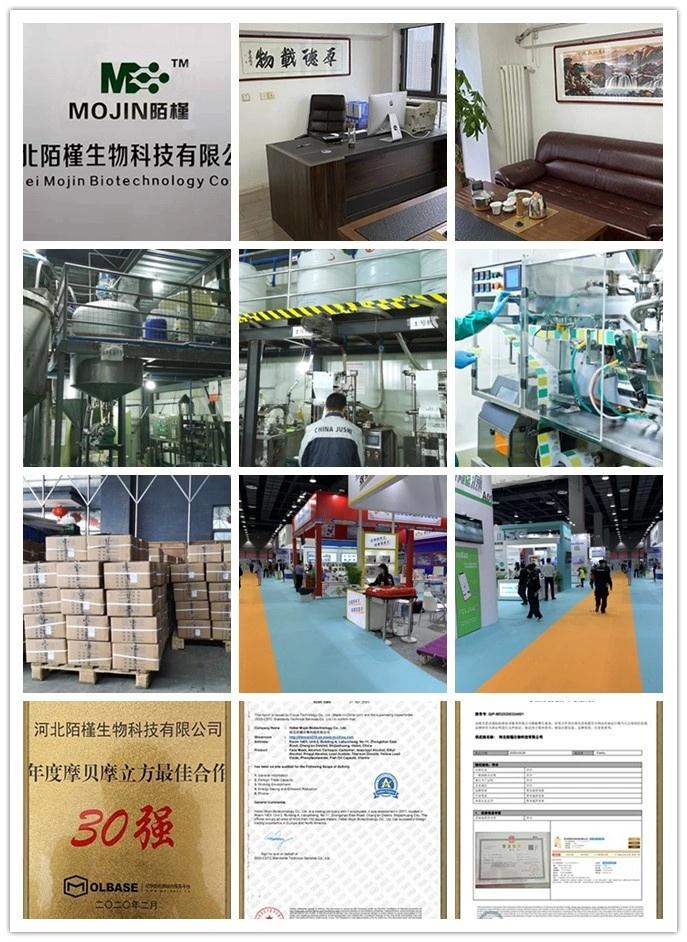| CAS: | 1078-61-1 |
| MF: | C9H10O4 |
| MW: | 182.17 |
| EINECS: | 214-083-8 |
| Product Categories: | Aromatics, Metabolites & Impurities, Pharmaceuticals, Intermediates & Fine Chemicals;Aromatic Cinnamic Acids, Esters and Derivatives |
| Mol File: | 1078-61-1.mol |
 |
|
| Dihydrocaffeic acid Chemical Properties |
| Melting point | 136-139 °C(lit.) |
| Boiling point | 418℃ |
| density | 1.398 |
| Fp | 220℃ |
| storage temp. | Inert atmosphere,Room Temperature |
| solubility | DMSO (Slightly), Methanol (Slightly) |
| pka | 4.75±0.10(Predicted) |
| form | Solid |
| color | Pale Beige to Pale Brown |
| Water Solubility | Slightly soluble in water. |
| BRN | 2213449 |
| InChI | InChI=1S/C9H10O4/c10-7-3-1-6(5-8(7)11)2-4-9(12)13/h1,3,5,10-11H,2,4H2,(H,12,13) |
| InChIKey | DZAUWHJDUNRCTF-UHFFFAOYSA-N |
| SMILES | C1(CCC(O)=O)=CC=C(O)C(O)=C1 |
| LogP | 0.115 (est) |
| CAS DataBase Reference | 1078-61-1(CAS DataBase Reference) |
| Dihydrocaffeic acid Usage And Synthesis |
| Description | Dihydrocaffeic acid is a polyphenol that has diverse biological activities, including antioxidant, neuroprotective, and enzyme inhibitory properties. Dihydrocaffeic acid scavenges ABTS (; IC50 = 81.86 μg/ml) and 2,2-diphenyl-1-picrylhydrazyl (DPPH; ; IC50 = 192.86 μg/ml) radicals and increases the survival of RGC-5 mouse retinal ganglion cells under hypoxic conditions and in the presence of S-nitroso-N-acetyl-D,L-penicillamine (SNAP; ) in a concentration-dependent manner. It also decreases endothelial nitric oxide synthase (eNOS) activity in EA.hy926 human endothelial cells in a concentration-dependent manner. In vivo, dihydrocaffeic acid (30 mg/kg) decreases infarct size in a rat model of transient ischemia induced by middle cerebral artery occlusion (MCAO). |
| Chemical Properties | Brown Solid |
| Uses | Dihydrocaffeic Acid is a natural product containing a catechol group with an α,β-unsaturated carboxylic acid chain. Dihydrocaffeic Acid has been shown to have hepatoprotective activity. Dihydrocaffei c Acid is a metabolite of Caffeic Acid (C08000) with potent antioxidant properties. |
| Uses | 3-(3,4-Dihydroxyphenyl)propionic acid it can be used to produce 3-(3,4-dihydroxy-phenyl)-propionic acid octyl ester by heating. |
| Definition | ChEBI: A monocarboxylic acid that is 3-phenylpropionic acid substituted by hydroxy groups at positions 3 and 4. It is a metabolite of caffeic acid and exhibits antioxidant activity. |
Packing:25kg/drum
Shipping:by sea or by air
Payment:T/T,western union,moneygram
Packaging Details drum
Port:Tianjin
Lead Time :
| Quantity(Kilograms) | 1 - 10000 | >10000 |
| Est. Time(days) | 5 | To be negotiated |

 Company information
Company information
Hebei Mojin Biotechnology Co., Ltd, Our company is a professional in 4'-Methylacetophenone,Levamisole hydrochloride ,N-Methylformamide and other chemical reagents research and development production enterprises. Our business covers more than 30 countries, most of the big customers come from Europe, America and other countries in the world, we can guarantee the quality and price. In recent decades, with the efforts of all employees, we have established many cooperative companies in shandong, henan, guangdong and other places. Our corporate purpose is based on the market, enhance the strength, take the road of scientific and environmental sustainable development, relying on the country. Technology r & d center, increase the investment in r & d, based on the domestic market, expand the international market, manufacturing quality products, sincere service to the society, into a modern, ecological, scientific and technological enterprise world.
 Advantage
Advantage
In stock
